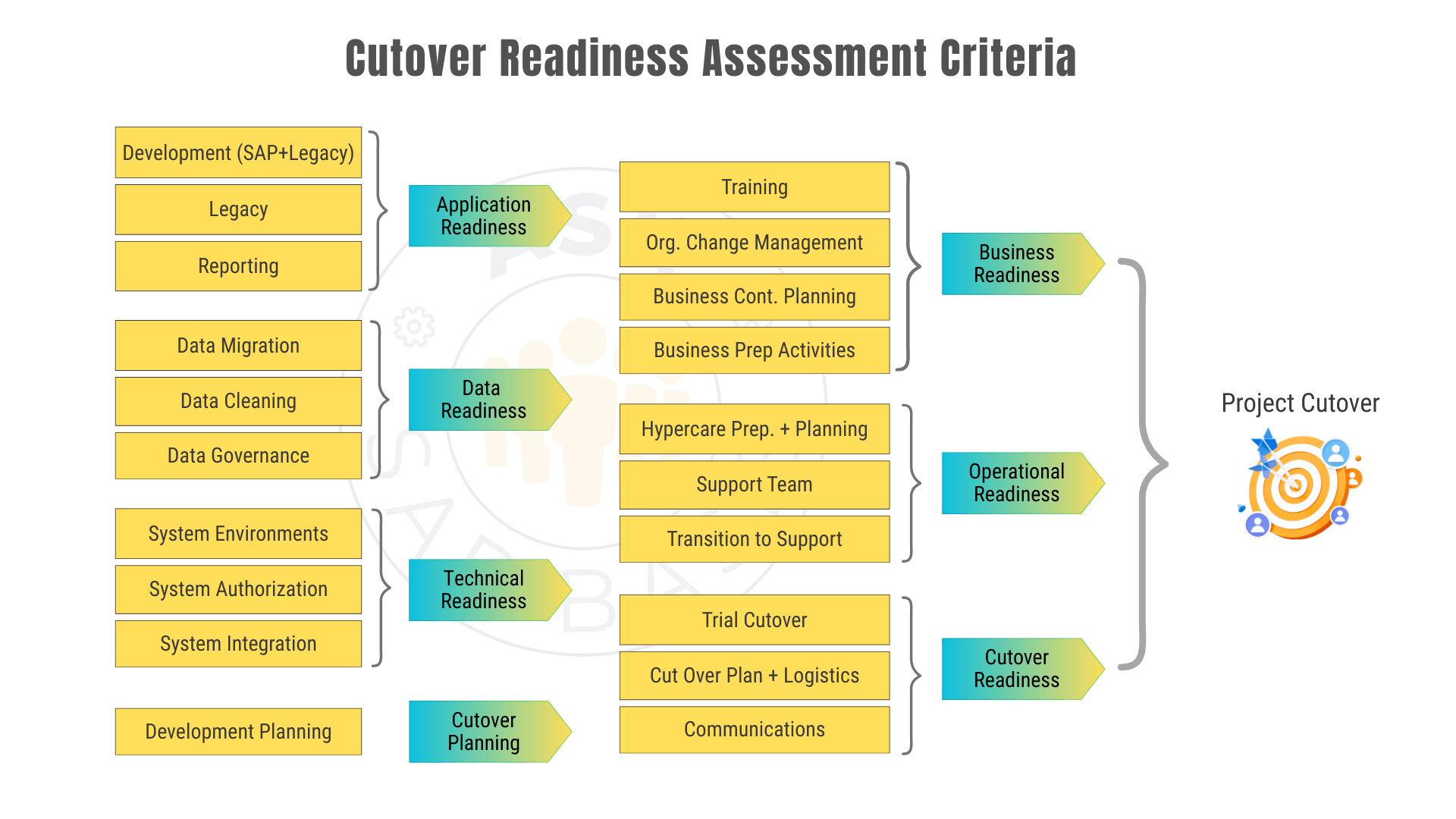SAP Cutover Plan and Readiness Checklist: Pre Go-Live Framework
Introduction
For any SAP project, the cutover phase represents the culmination, the ultimate acid test. It marks the definitive shift from legacy systems to your new, integrated SAP environment. This is more than just a technical event; it’s a strategic business transformation. Managing this inherently complex and high-pressure phase effectively requires unwavering control and a clear understanding of readiness, because even small missteps can lead to costly downtime or operational chaos.
This article introduces the SAP Project Cutover Readiness Assessment Framework, a systematic approach designed to objectively evaluate every facet of your project’s preparedness, guiding you towards a successful and stable go-live. . By identifying potential gaps and risks, this assessment helps ensures a seamless cutover process, minimizing disruptions and sets your organization up for long-term success. In this section, we’ll explore the key components of this assessment and why it’s a vital step in every SAP project journey.
Cutover Readiness Assessment Framework
The SAP Project Cutover Readiness Assessment Framework is a structured “playbook” that guides you through a rigorous, objective check of everything you and your organization need in place before you flip the switch to go live with SAP. Derived from countless SAP implementations worldwide, it offers a comprehensive, fact-based approach to evaluating three critical readiness domains—project team, business stakeholders, and technical solution.
Designed primarily for SAP project managers and cutover leads, it provides a baseline methodology and modular templates (via the SAP Activate Roadmap Viewer) that can be tailored to the specific demands of any engagement.
Core Principles
At its heart, the framework focuses on assessing the readiness of the project team, business, and SAP solution to commence the Production Cutover. It does so by adhering to three fundamental principles:

1) Cutover Readiness Assessment Criteria
Before the countdown to cutover even begins, this principle mandates to establish a fixed or pre-defined set of clear, measurable go/no-go readiness checkpoints. By defining “must-have” criteria grouped into categories such as Application, Data, Technical, Cutover Planning, Business Preparation, IT Operations, and Final Cutover you eliminate guesswork and last-minute bias. This ensures you eliminate guesswork and last minute bias, and your every decision is based on facts not pressure or timelines.
They are typically grouped (and tailored as per project type, complexity, scope etc):
- Application
- Data
- Technical
- Cutover Planning
- Business Preparation
- IT Operations
- Final Cutover
Commonly implemented as:
- Binary checks (“Yes/No” questions).
- Progressive scales (e.g., 1–5 readiness ratings).
- Threshold values (minimum/maximum performance or data quality levels).
- Priority ratings (to highlight mission-critical items).

These objective standards become the single source of truth—so when you arrive at your “Go/No-Go” decision, it’s guided purely by data, not by calendar pressure.
2) Cutover Checkpoints
A successful cutover isn’t just about code and configurations; it’s a business transformation. This principle broadens the assessment lens to include:

- Application Readiness:
- All critical configurations are complete and validated according to design specifications.
- All SAP modules and custom developments have passed unit and integration tests.
- Critical interfaces are connected and exchanging data in a test environment, with key integrations thoroughly tested and validated across all SAP modules and external systems.
- Custom developments are deployed, validated, and functioning as expected within the new system.
- Data Readiness:
- Initial full data load has executed without errors.
- Master data is cleansed, transformed, and accurately migrated to the new SAP system.
- Transactional data conversion is validated and reconciled, with reconciliation reports showing no significant discrepancies between legacy and target.
- Key data quality metrics (completeness, accuracy) meet agreed thresholds.
- Data load performance targets are met, ensuring efficient transfer during the cutover window.
- Technical Readiness:
- System landscape (DEV/QAS/PRD) configurations are aligned.
- Performance tests (batch jobs, reports, transaction volumes) are within acceptable limits.
- Transport and deployment processes are rehearsed end-to-end.
- The new SAP system is correctly set up, configured, and functioning according to the meticulously defined design.
- Transport and deployment processes are rehearsed end-to-end.
- Disaster recovery and backup procedures are defined, tested, and ready for the new environment.
- Cutover Planning:
- Roles & responsibilities (including backups) are confirmed and contact details distributed.
- A dry-run of the runbook has been executed, with lessons captured and the schedule updated.
- The cutover runbook, detailing task lists, owner assignments, and timings, is fully documented and approved by all key stakeholders.
- Comprehensive contingency plans are defined, reviewed, and tested to handle unexpected issues or delays during the transition.
- Cutover logistics, including physical and IT setup, necessary tools, and access, are fully prepared and verified.
- Business Readiness:
- Leadership commitment and active sponsorship are secured and visible.
- All end-users are comprehensively trained, user engagement is high, and cultural resilience is assessed to ensure adaptation to new processes.
- Key business processes are aligned, documented for day-one operations, and the organization’s process maturity supports the new SAP environment.
- Organizational change management activities, including strategic communication and proactive stakeholder engagement, are completed to foster adoption.
- Process maturity and documentation of day-one operations.
- Cutover Readiness
- Final validation of readiness to execute the actual cutover.
- Resource availability, shift rosters, and contingency plans are locked.
- Communication war rooms and support channels are active and ready.
- All individual readiness categories (Application, Data, Technical, Cutover Planning, Business, Operational) have achieved their “Green Status”.
- The comprehensive assessment, leveraging pre-defined criteria, confirms the project’s overall preparedness to commence the Production Cutover.
- All identified risks and issues have been mitigated or have clear, approved resolution plans in place.
- The cutover simulation or dress rehearsal has been successfully completed, building confidence in the execution plan and team.
- Go/No-Go criteria are confirmed and signed off.
- IT Operations Readiness:
- Infrastructure monitoring and backup strategies are in place.
- Rollback procedures and support-desk scripts are tested and kept in-place.
- The post-go-live support team is established, trained, and fully prepared to provide continuous assistance, including the “Hyper Care” period.
- Monitoring tools and dashboards are configured and tested to track system performance, security, and overall stability in real-time.
- Incident management and escalation procedures are clearly defined and communicated for rapid issue resolution.
- Knowledge transfer to the Business as Usual (BAU) support team is completed, covering system configurations, processes, and common issue resolution.
By evaluating both human and technical factors, you surface the true readiness of your organization to function in the new environment and avoid the classic pitfall of “perfect system, unprepared users.”
3) Continuous Readiness Monitoring
Readiness isn’t a one-and-done tick box; it’s a continuous journey. This principle embeds regular progress reviews into the project’s Deploy phase:
- Proactive Monitoring: Monitoring progress towards readiness should begin as early as possible in the project life-cycle. The primary objective is to achieve a “Green Status” for all defined criteria, meaning all issues are resolved and preparations are complete.
- Cutover Checkpoints: Key decision gates, such as Cutover Simulations and the Production Cutover kickoff—where readiness is formally assessed.
- Status Meetings: Weekly (or more frequent) forums to review each criterion’s status (Green/Amber/Red), escalate blockers, and drive corrective actions.
- Real-Time Dashboards & Automated Alerts: Tools like DCS Watch can centralize readiness data, flag emerging risks, and broadcast status changes to all stakeholders.
- Systematic Risk & Issue Management: A living registry of Risks, Assumptions, Issues, and Dependencies (RAID) log, that’s updated alongside your readiness scores.
By starting early and maintaining a relentless focus on “turning Amber or Red items Green,” you build in the lead time needed to remediate issues—transforming cutover from a high-pressure scramble into a controlled, predictable milestone.
Conclusion
Successfully transitioning to a live SAP system isn’t just about flipping a switch — it’s about orchestrating a highly coordinated, multi-dimensional shift across people, processes, and technology. The SAP Cutover Readiness Assessment Framework helps project teams assess this complexity with clarity and confidence. By evaluating readiness across all key dimensions — from application stability to business preparedness, and from cutover planning to IT operations — it empowers decision-makers to spot gaps early, reduce risk, and execute with precision.
It’s important to remember that the framework illustrated in this blog serves as a foundational example. Like every SAP project, it’s designed to be adaptable, evolving to fit the size, scope, and unique dynamics of your organization. Whether you’re running a greenfield S/4HANA implementation or a phased rollout, this framework is your blueprint for a controlled and confident go-live.


